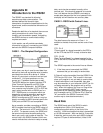36
U419. Analog switch U418 selects the time constant
and gain. The full scale output of U418 is 5 volts.
The quadrature demodulator and low pass amplifiers
are identical to that described above. The
quadrature detector output is provided by U1119.
Analog Output and Control
The dc output of the demodulator/low pass
amplifiers is passed to the reference input of
multiplying DAC U502. The DAC is programmed
with the appropriate attenuation to calibrate the
overall gain of the lock-in. Every gain setting in each
dynamic reserve is calibrated independently and the
proper attenuations are stored in the unit's ROM.
The quadrature output is calibrated by DAC U1201.
Amplifiers U1204 and U1205 buffer the two
demodulator outputs to drive the X and Y BNC's.
A/D's
Analog multiplexer U504 selects the signal to be
digitized by the microprocessor. This signal can be
either the lock-in's in-phase or quadrature output or
one of the four independent analog inputs buffered
by U501. These general purpose inputs are located
on the rear panel of the instrument. The selected
signal is sampled and held on capacitor C502 and
buffered by 4/4 U508. The A/D conversion is done
by successive approximation using comparator
U514 to compare the sampled and held signal with
known outputs of U505, a 12 bit DAC with a
precision reference. Note that the output of U506,
an 8 bit DAC is summed with the output of U505.
This 8 bit DAC corrects for offset errors which can
accumulate as analog voltages pass through
buffers, S/H amps, and comparators. These offsets
are measured after each unit is manufactured, and
values to compensate for these offsets are placed in
the unit's ROM. The polarity of the offset-corrected
12 bit DAC is set by 2/4 U511 and the SIGN bit
yielding 13 bits of resolution from -10.24 to +10.24
volts.
D/A's
In addition to providing reference voltages for A/D
conversion, the DAC output voltage may be
multiplexed by U507 to one of eight sample and hold
amplifiers which provide analog output and control
voltages. The microprocessor refreshes each S/H
amplifier every few milliseconds to prevent droop.
Two of these outputs are available as general
programmable outputs on the rear panel. Two are
used to program the band pass filter and the
reference oscillator phase shift. One output is
subtracted from the lock-in output in U508 to
provide a variable offset and another is the rms
noise output. The remaining two outputs
generate the magnitude and phase output
voltages.
Expand
3/4 U511 and 4/4 U1202 are the expand
amplifiers. They provide a selectable gain of 10
to the channel 1 and 2 outputs just before the
output buffers.
Front Panel
There are 71 led's on the front panel controlled
by 9 serial-in, parallel-out shift registers. 8 of the
shift registers are written to simultaneously and
the 9th is written separately. 8 consecutive write
operations are required to set the LED's in each
case. The liquid crystal displays are managed
by the display controllers, U6101, U6102, and
U6103. Exclusive-or gates U6104, U6105 and
U6106 drive the left over segments. Latches
U6107 and U6108 provide the logic bits for
these extra segments as well as the keyboard
row strobes. U6109 reads the switch closures
as the rows are scanned.
Microprocessor Control
The microprocessor, U701, is a Z80A CPU
clocked at 4 MHz. 16K bytes of firmware are
stored in the ROM, U702. U703 is a 2K byte
static RAM, backed-up by a lithium battery. A
power-down standby circuit, Q701, preserves
the RAM contents when the power is turned off.
The battery has a life of 5-10 years. The CPU
has power-up and power-down resets to prevent
erroneous execution during turn-on or short
sags in the line voltage.
U704 is a 3-channel counter. One channel
generates the baud rate for the RS232 interface
while the other two are used to measure the
frequency or period of the reference oscillator.
U709 provides a gate pulse to counter 0.
Multiplexer U708 selects whether the gate is a
single period of the reference (period
measurement) or a gate of known duration
(frequency measurement). Counter 1 is a
programmable divide by N counter whose output
is either counted for one period of the reference,


















